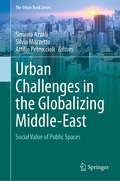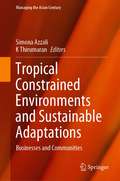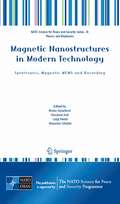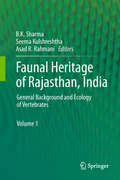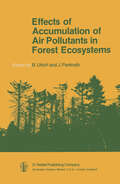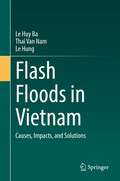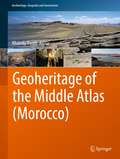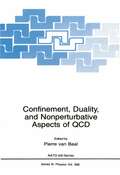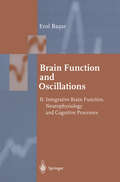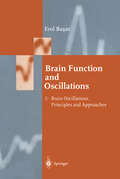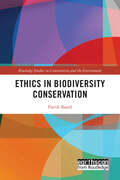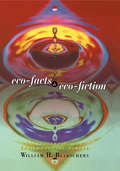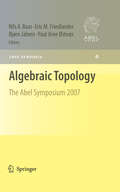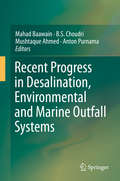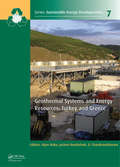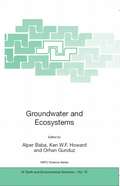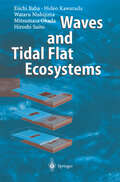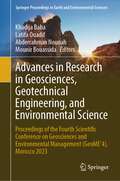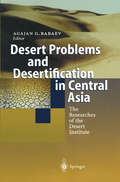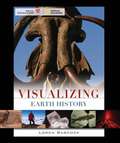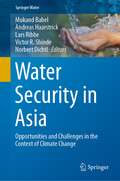- Table View
- List View
Urban Challenges in the Globalizing Middle-East: Social Value of Public Spaces (The Urban Book Series)
by Simona Azzali Silvia Mazzetto Attilio PetruccioliThis publication aims to investigate the nature of social life in public and urban spaces in the cities of the Middle East, considering the value of environmental approaches. It aims to develop a better understanding of the patterns of social interactions and activities in public places, which have been influenced by cultural heritage values.Sustainable and livable open spaces can help in improving living conditions in cities. Public spaces are relevant as they satisfy many human needs. In public spaces, people interact and meet; people with different cultures and social backgrounds can communicate and learn from each other in social and spontaneous ways. However, decision-makers tend to forget the value of public spaces, especially in the absence of a national regulatory framework in emerging globalized cities.The book provides a multi-disciplinary approach in reading the characteristics and values of public spaces in the emerging cities of the Middle East.
Tropical Constrained Environments and Sustainable Adaptations: Businesses and Communities (Managing the Asian Century)
by Simona Azzali K ThirumaranThis book investigates resource-constrained environments in the tropics and subtropics where people’s lives and businesses are affected, and adaptations occur periodically. Constrained environments are unique territories characterised by challenging circumstances, limited land and natural resources. They can be places with a small municipal boundary or cities in which parts around them may be consumed by ocean, bay or mountains. Those places face hard physical boundaries like coastlines and mountains, which in addition to policy decisions that may limit height or density, can also serve to limit capacity for expansion. Successful communities and businesses tend to survive in a changing environment given their strong intuitive and forward-looking adaptations.This book delves into the role of urban planning and design in the promotion of business and adaptations of people and communities. Additionally, the focus takes into account impact analysis and the effects of an expanding populations, including growing migrant flows, and business needs on the built environment of land-constrained territories
Magnetic Nanostructures in Modern Technology: Spintronics, Magnetic MEMS and Recording (NATO Science for Peace and Security Series B: Physics and Biophysics)
by Bruno Azzerboni Giovanni Asti Luigi Pareti Massimo GhidiniIn this book, a team of outstanding scientists in the field of modern magnetic nanotechnologies illustrates the state-of-the-art in several areas of advanced magneto-electronic devices, magnetic micro-electromechanical systems and high density information storage technologies. Providing a unique source of information for the young physicist, chemist or engineer, the book also serves as a crucial reference for the expert scientist and the teacher of advanced university courses.
Faunal Heritage of Rajasthan, India: General Background and Ecology of Vertebrates
by B. K. Sharma, Seema Kulshreshtha and Asad R. RahmaniThis is the first ever monumental and scientific documentation of the faunal wealth of the Indian Desert state of Rajasthan. This volume, the first of two, provides background on Rajasthan and covers species diversity and distribution of fauna. A scholarly contribution to the field of knowledge, it provides novel and vital information on the vertebrate faunal heritage of India’s largest state. Broadly falling under the Indo-Malaya Ecozone, the three major biomes of Rajasthan include deserts and xeric shrublands, tropical and subtropical dry broadleaf forests, and tropical and subtropical moist broadleaf forests. The corresponding ecoregions to the above biomes are, respectively, the Thar Desert and northwestern thorn scrub forests, the Khathiar-Gir dry deciduous forests, and the Upper Gangtic Plains moist deciduous forests. Contrary to popular belief, the well-known Thar or Great Indian Desert occupies only a part of the state. Rajasthan is diagonally divided by the Aravalli mountain ranges into arid and semi-arid regions. The latter have a spectacular variety of highly diversified and unique yet fragile ecosystems comprising lush green fields, marshes, grasslands, rocky patches and hilly terrains, dense forests, the southern plateau, fresh water wetlands, and salt lakes.Apart from the floral richness, there is faunal abundance from fishes to mammals. In this volume, the various flagship and threatened species are described in the 24 chapters penned by top notch wildlife experts and academics. The world famous heronry, tiger reserves, wildlife sanctuaries and some threat-ridden biodiversity rich areas shall certainly draw the attention of readers from around the world.
Effects of Accumulation of Air Pollutants in Forest Ecosystems: Proceedings of a Workshop held at Göttingen, West Germany, May 16–18, 1982
by B. Ulrich and J. PankrathThis volume is based on a workshop on "Effects of accumulation of air pollutants in forest ecosystems'; held in GOttingen, Federal Republic of Germany, from May 16-18, 1982. This work'shop was initiated and sponsored by the Environmental Agency of the Federal Republic of Germany (project officer: Dr. J. Pankrath) as part of a research contract (project leader: Dr. B. Ulrich). THE PROBLEM SEEN UNDER THE ASPECT OF ADMINISTRATION The problem of forest damage caused by air pollution is not new in Europe. Already in 1983 a comprehensive report from Schroeder and Reuss about vegetation damages by fume in the Harz mountains was published. In 1923, Prof. Dr. Julius Stocklasa of the Bohemian Technical Highschool in Prague was concerned with research of toxical effects of sulphur dioxide in his publication "The damage of vegetation by flue gas and exhalations of facili ties". This comprehensive and instructive work concludes with the sentence: "It is already high time for the governments of all cultural states to take legal, police and private measures in order to prevent damage by flue gases". In the neighbourhood of industries with high gaseous and dust emissions damages have been shown to occur for a long timei these deleterious effects have influenced the growth of trees and in extreme cases have even caused their early death.
Flash Floods in Vietnam: Causes, Impacts, and Solutions
by Le Huy Ba Thai Van Nam Le HungThis book discusses the threats and impacts of flash floods in Vietnam on environmental, human, and socio-economic resources, and covers monitoring, forecasting, warning, urgent action plans, and prevention solutions. While the work focuses on cases in Vietnam, it is applicable to many regions in the world that experience flash flooding as a common occurrence. Through data collection, field surveys, and investigational statistics from a specialized group of authors, the book provides comprehensive background knowledge on flash floods, and a flash flood hazard map using remote sensing and GIS techniques that can be used to assess the likelihood and potential impacts of flash floods before vulnerable areas and populations can be threatened. The intended audience of this manuscript is people interested in the fields of weather, environment, and natural disasters. It will serve as a reference for environmental managers, administrators of disaster planning, and extreme weather scientists.
Geoheritage of the Middle Atlas (Geoheritage, Geoparks and Geotourism)
by Khaoula BaadiThis book is a condensed summary of a broad spectrum of the geological heritage of the Middle Atlas. It has the particularity of proposing an in-depth synthesis and a critical review of the geoheritage of the region. The book addresses the issues related to geoheritage and methodologies for the selection, inventory, assessment and preservation of geosites. It reviews the state of the art of geoheritage in Morocco, particularly in the Middle Atlas, in order to identify geosites with rare and unique geological features. The book presents a detailed study of lithostratigraphic and sedimentological heritage as geosites witnessing at different spatial and temporal scales the evolution and the stratigraphic, sedimentological and paleogeographic history of the Middle Atlas range. It also presents the paleontological heritage of vertebrates by reviewing the discoveries of paleontological sites and their risks in order to present its conservation plans. It also addresses the hydric and fluvial heritage by presenting the potential of water resources and the impact of climate change on the latter. Furthermore, it highlights the karst heritage by exposing an inventory of exo- and endokarst geosites in order to emphasize some unique sites on a national and African scale as well as revealing the underground biodiversity related to this heritage. Finally, it proposes a presentation of the volcanic heritage in order to assess the volcanic geosites that testify to the strombolian, phreatomagmatic and Hawaiian dynamism of the region. The book is mainly intended for researchers, geologists and specialists of the Moroccan Middle Atlas region wishing to acquire a broad multidisciplinary or even transdisciplinary knowledge. It will also be accessible to a non-initiated public, interested in the richness of the Moroccan geoheritage, as well as to Moroccan territorial authorities (High Commission for Water and Forests, Ministry of Tourism, National Institute of Archaeology and Heritage Sciences, etc.) who can benefit from it in the perspective of their strategies of preservation of the national geological heritage. This work will be an example for geoscientists, on an African scale, of a valorization of territorial geological heritage.
Mikromagnetische Charakterisierung des Ermüdungsverhaltens und der Eigenspannungsrelaxation tiefgebohrter Proben des Vergütungsstahls 42CrMo4 (Werkstofftechnische Berichte │ Reports of Materials Science and Engineering)
by Nikolas BaakNikolas Baak befasst sich mit der Qualifizierung mikromagnetischer Methoden zur Bewertung der durch Tiefbohren erzeugten Randzonen hinsichtlich ihrer Oberflächenintegrität und deren Einfluss auf das Ermüdungsverhalten. Dabei wird das Ziel verfolgt, durch den Bohrprozess einen vorteilhaften Eigenspannungszustand zu erreichen. Beim hier eingesetzten Einlippen-Tiefbohren kommt es aufgrund des asymmetrischen Werkzeugaufbaus zu einer Art Festwalzprozess. Dadurch werden sowohl sehr hohe Oberflächengüten, als auch der gewünschte Druckeigenspannungszustand erzeugt. Da die meisten Verfahren zur Bestimmung der Oberflächenintegrität entweder zerstörend sind oder auch einen freien Zugang zur Oberfläche benötigen, werden hier zerstörungsfreie Prüfverfahren dafür ertüchtigt, die Oberflächenintegrität sowie den Ermüdungszustand der Bauteile zu bestimmen. Für beide hier betrachteten mikromagnetischen Verfahren, einerseits die Barkhausenrauschen-Analyse und andererseits die Wirbelstromprüfung, werden speziell angefertigte Sensoren, welche das Messsignal an der Innenseite der Bohrung detektieren können, verwendet. Die Messdaten der mikromagnetischen Verfahren werden mit den etablierten Verfahren zur Bestimmung der Oberflächenintegrität, wie bspw. Röntgendiffraktometrie, korreliert.
Confinement, Duality, and Nonperturbative Aspects of QCD (Nato Science Series B: #368)
by Pierre Van BaalProceedings of a NATO ASI and Isaac Newton Institute Workshop held in Cambridge, UK, June 23-July 4, 1997
The Theoretical Foundations of Quantum Mechanics
by Belal E. BaaquieThe Theoretical Foundations of Quantum Mechanics addresses fundamental issues that are not discussed in most books on quantum mechanics. This book focuses on analyzing the underlying principles of quantum mechanics and explaining the conceptual and theoretical underpinning of quantum mechanics. In particular, the concepts of quantum indeterminacy, quantum measurement and quantum superposition are analyzed to clarify the concepts that are implicit in the formulation of quantum mechanics.The Schrodinger equation is never solved in the book. Rather, the discussion on the fundamentals of quantum mechanics is treated in a rigorous manner based on the mathematics of quantum mechanics. The new concept of the interplay of empirical and trans-empirical constructs in quantum mechanics is introduced to clarify the foundations of quantum mechanics and to explain the counter-intuitive construction of nature in quantum mechanics.The Theoretical Foundations of Quantum Mechanics is aimed at the advanced undergraduate and assumes introductory knowledge of quantum mechanics. Its objective is to provide a solid foundation for the reader to reach a deeper understanding of the principles of quantum mechanics.
Brain Function and Oscillations: Volume II: Integrative Brain Function. Neurophysiology and Cognitive Processes (Springer Series in Synergetics)
by Erol BaşarNeuroscience is ripe for a paradigm change as Freeman and Mountcastle describe. Brain Oscillations provide an important key to this change. In this book the functional importance of the brain's multiple oscillations is treated with an integrative scope. According to the author, neurophysiology and cognition demand integrative approaches similar to those of Galilei and Newton in physics and of Darwin in biology. Not only the human brain but also lower brains and ganglia of invertebrates are treated with electrophysical methods. Experiments on sensory registration, perception, movement, and cognitive processes related to attention, learning, and memory are described. A synopsis on brain functions leads to a new neuron assemblies doctrine, extending the concept of Sherrington, and new trends in this field. The book will appeal to scientists and graduate students.
Brain Function and Oscillations: Volume I: Brain Oscillations. Principles and Approaches (Springer Series in Synergetics)
by Erol Başarby W. J. Freeman These two volumes on "Brain Oscillations" appear at a most opportune time. As the "Decade of the Brain" draws to its close, brain science is coming to terms with its ultimate problem: understanding the mechanisms by which the immense number of neurons in the human brain interact to produce the higher cognitive functions. The ideas, concepts, methods, interpretations and examples, which are presented here in voluminous detail by a world-class authority in electrophysiology, summarize the intellectual equipment that will be required to construct satisfactory solutions to the problem. Neuroscience is ripe for change. The last revolution of ideas took place in the middle of the century now ending, when the field took a sharp turn into a novel direction. During the preceding five decades the prevailing view, carried forward from the 19th century, was that neurons are the carriers of nerve energy, either in chemical or electrical forms (Freeman, 1995). That point of view was enormously productive in terms of coming to understand the chemical basis for synaptic transmission, the electrochemistry of the ac tion potential, the ionic mechanisms of membrane currents and gates, the functional neuroanatomy that underlies the hierarchy of reflexes, and the neural fields and'their resonances that support Gestalt phenomena. No bet ter testimony can be given of the power of the applications of this approach than to point out that it provides the scientific basis for contemporary neu rology, neuropsychiatry, and brain imaging.
Ethics in Biodiversity Conservation (Routledge Studies in Conservation and the Environment)
by Patrik BaardThis book examines the role of ethics and philosophy in biodiversity conservation. The objective of this book is two-fold: on the one hand it offers a detailed and systematic account of central normative concepts often used, but rarely explicated nor justified, within conservation biology. Such concepts include ‘values’ (both intrinsic, instrumental, and, more recently, relational), ‘rights’, and ‘duties’. The second objective is to emphasize to environmental philosophers and applied ethicists the many interesting decision-making challenges of biodiversity conservation. The book argues that a nuanced account of instrumental values provides a powerful tool for reasoning about the values of biodiversity. It also scrutinizes relational values, the concept of rights of nature, and risk, and show how moral philosophy proves indispensable for these concepts. Consequently, it engages with recent suggestions on normative aspects of biodiversity conservation, and show the need for moral philosophy in biodiversity conservation. The overriding aim of this book is to provide conservation biologists and policy-makers with a systematic overview of concepts and assessments of the reasons for reaching prescriptive conclusions about biodiversity conservation. This will prove instrumental in clarifying the role of applied ethics and a refined understanding of the tools it can provide. This title will be of interest to students and scholars of conservation biology, conservation policy, environmental ethics and environmental philosophy.
Ethics in Biodiversity Conservation (Routledge Studies in Conservation and the Environment)
by Patrik BaardThis book examines the role of ethics and philosophy in biodiversity conservation. The objective of this book is two-fold: on the one hand it offers a detailed and systematic account of central normative concepts often used, but rarely explicated nor justified, within conservation biology. Such concepts include ‘values’ (both intrinsic, instrumental, and, more recently, relational), ‘rights’, and ‘duties’. The second objective is to emphasize to environmental philosophers and applied ethicists the many interesting decision-making challenges of biodiversity conservation. The book argues that a nuanced account of instrumental values provides a powerful tool for reasoning about the values of biodiversity. It also scrutinizes relational values, the concept of rights of nature, and risk, and show how moral philosophy proves indispensable for these concepts. Consequently, it engages with recent suggestions on normative aspects of biodiversity conservation, and show the need for moral philosophy in biodiversity conservation. The overriding aim of this book is to provide conservation biologists and policy-makers with a systematic overview of concepts and assessments of the reasons for reaching prescriptive conclusions about biodiversity conservation. This will prove instrumental in clarifying the role of applied ethics and a refined understanding of the tools it can provide. This title will be of interest to students and scholars of conservation biology, conservation policy, environmental ethics and environmental philosophy.
Eco-facts and Eco-fiction: Understanding the Environmental Debate
by William H. BaarschersOzone-friendly, recyclable, zero-waste, elimination of toxic chemicals - such environmental ideals are believed to offer solutions to the environmental crisis. Where do these ideals come from? Is the environmental debate communicating the right problems? Eco-Facts and Eco-Fiction examines serious errors in perceptions about human and environmental health. Drawing on a wealth of everyday examples of local and global concerns, the author explains basic concepts and observations relating to the environment. Removing fear of science and technology and eliminating wrong perceptions lead to a more informed understanding of the environment as a science, a philosophy, and a lifestyle. By revealing the flaws in today's environmental vocabulary, this book stresses the urgent need for a common language in the environmental debate. Such a common language encourages the effective communication between environmental science and environmental decision-making that is essential for finding solutions to environmental problems.
Eco-facts and Eco-fiction: Understanding the Environmental Debate
by William H. BaarschersOzone-friendly, recyclable, zero-waste, elimination of toxic chemicals - such environmental ideals are believed to offer solutions to the environmental crisis. Where do these ideals come from? Is the environmental debate communicating the right problems? Eco-Facts and Eco-Fiction examines serious errors in perceptions about human and environmental health. Drawing on a wealth of everyday examples of local and global concerns, the author explains basic concepts and observations relating to the environment. Removing fear of science and technology and eliminating wrong perceptions lead to a more informed understanding of the environment as a science, a philosophy, and a lifestyle. By revealing the flaws in today's environmental vocabulary, this book stresses the urgent need for a common language in the environmental debate. Such a common language encourages the effective communication between environmental science and environmental decision-making that is essential for finding solutions to environmental problems.
Algebraic Topology: The Abel Symposium 2007 (Abel Symposia #4)
by Nils Baas Eric Friedlander Bjö Jahren Paul Arne ØstværThe 2007 Abel Symposium took place at the University of Oslo in August 2007. The goal of the symposium was to bring together mathematicians whose research efforts have led to recent advances in algebraic geometry, algebraic K-theory, algebraic topology, and mathematical physics. A common theme of this symposium was the development of new perspectives and new constructions with a categorical flavor. As the lectures at the symposium and the papers of this volume demonstrate, these perspectives and constructions have enabled a broadening of vistas, a synergy between once-differentiated subjects, and solutions to mathematical problems both old and new.
Recent Progress in Desalination, Environmental and Marine Outfall Systems
by Mahad Baawain B. S. Choudri Mushtaque Ahmed Anton PurnamaThis book collects current scientific information on advanced technologies and management practices associated with the desalination industry in the Middle East and elsewhere around the world. The book opens with introductory chapter which briefly recounts the history of desalination, and describes the current state of development in the field.Part I: Desalination Systems includes ten chapters which describe a variety of techniques and designs intended not only to minimize the impact of desalination, but also to save energy and use natural resources to maximize the output of integrated desalination systems. Among the highlights are a chapter on the use of ceramic membrane technology for sustainable oil water production; a case study on the use of solar heating systems in desalination technology in Oman; discussion of fouling and its effect on design and performance of desalination systems; a review of shore approaches and sea-lines with case studies from Australia and Germany; and a discussion of the integration of desalination technology with renewable energy for climate change abatement in the Middle East and North Africa region.Part II: Environmental Systems includes among others a chapter on regulating the use of water resources and desalination technology on a regional scale reducing the carbon footprint of desalination, with examples from Australia; a description of desalination for irrigation in the Souss Massa region in the south of Morocco; a study of the impact of the coastal intake environment on operating conditions of thermal desalination plants in the United Arab Emirates; a discussion of hydrodynamic and thermal dispersion modeling of the effluent in a coastal channel, with a case study from Oman; and a mathematical model study of effluent disposal from a desalination plant in the marine environment at Tuticorin in India.The book aims to inspire developments in desalination technologies which are specifically aimed at reducing energy consumption and cost, and minimizing environmental impact.
Geothermal Systems and Energy Resources: Turkey and Greece
by Alper Baba Jochen Bundschuh D. ChandrasekharamIn the region comprising Turkey and Greece, people have been using water from geothermal sources for bathing and washing of clothes since ancient times. This region falls within the Alpine-Himalayan orogenic belt and hence is a locus of active volcanism and tectonism and experiences frequent seismic events. This volcanic and tectonic activity has g
Groundwater and Ecosystems (Nato Science Series: IV: #70)
by Alper Baba Ken W. F. Howard Orhan GunduzMany problems related to groundwater and ecosystems are shared by countries throughout the world and there is growing recognition that much can be gained by co-operation on an international scale. This is no time for complacency and it is critical that key problems be identified, that the potential consequences of these problems be understood, and that the development of solutions begins urgently. Important data gaps must be recognized and filled without delay.
Waves and Tidal Flat Ecosystems
by Eiichi Baba Hideo Kawarada Wataru Nishijima Mitsumasa Okada Hiroshi SuitoThe authors explain the rewarding results from the interdisciplinary collaboration between an environmental study group working on coastal ecosystems and effects of oil spills and applied mathematicians modelling wave motion on sandy beaches. By using the unified Navier-Stokes equations with a Bingham fluid model for spilled oil, multi-phase flow analysis were made. Decomposition of spilled oil by bacteria was simulated as a chemical reaction, and the theoretical and numerical analysis suggested a countermeasure to help reduce stress on coastal ecosystems. The new understanding of how ecosystems both depend upon, and help to determine, the nature of the shoreline demonstrates promising ways to better assist and exploit the regenerative powers inherent in nature.
Advances in Research in Geosciences, Geotechnical Engineering, and Environmental Science: Proceedings of the Fourth Scientific Conference on Geosciences and Environmental Management (GeoME’4), Morocco 2023 (Springer Proceedings in Earth and Environmental Sciences)
by Khadija Baba Latifa Ouadif Abderrahman Nounah Mounir BouassidaThe industrial acceleration intensifies the negative environmental impacts, mainly in some very sensitive geographical areas. Environmental problems like water stress, deadly floods, scarcity of building materials, and prolonged periods of drought affect southern countries, including African nations. This book comprises the peer-reviewed proceedings of the fourth scientific conference on geosciences and environmental management (GeoME'4), held in Salé, Morocco, on June 22–24, 2023. The book interests all researchers, practitioners, and students in geosciences, the environment, and water management.The book delivers a comprehensive overview of the latest research covering the following aspects of green technologies for sustainable water and wastewater management: nature-based solutions in the water cycle and advanced technologies in geosciences, geotechnics, and the environment. Additionally, it features six keynote speakers by international experts, providing valuable insights and further enhancing its value as a comprehensive resource on the following topics: Water management Environmental engineeringGeosciences and geotechnical engineering
Desert Problems and Desertification in Central Asia: The Researchers of the Desert Institute
by Agajan G. BabaevSince 1962 the Desert Institute of the former Academy of Science of the USSR has been conducting research work in the arid and semi-arid zones of central Asia. This outstanding experience in desert and desertification problems, and the possibilities of sustainable land use under difficult environmental conditions is summarized here. The book also gives an overview of the Institute's consulting work within the framework of international projects. This is the first publication allowing readers outside the Russian-speaking world to obtain concise information about the specific constraints and development possibilities of central Asian drylands.
Visualizing Earth History (Visualizing Series)
by Loren E. BabcockPresenting a new vision in the field, this compelling book explores Earth's history as a series of interrelated processes that continue to have significant outcomes for humans and other living things. It captures the excitement of historical geology by utilizing active, visually rich learning methods. Readers will gain a strong understanding of the fundamental concepts used in the interpretation of Earth's physical, chemical, and biological evolution over the last 4.5 billion years. They'll also discover how to interpret the interaction of living creatures with their environments through time by following the book's innovative framework.
Water Security in Asia: Opportunities and Challenges in the Context of Climate Change (Springer Water)
by Mukand Babel Andreas Haarstrick Lars Ribbe Victor R. Shinde Norbert DichtlThis book assesses the current water-security situation in Asia. The thematic areas of the book discuss the United Nation’s sustainable development goals with a particular focus on Goal 6 (“Ensure availability and sustainable management of water and sanitation”) and Goal 13 (“Take urgent action to combat climate change and its impacts”). Asia has been facing a number of water-related challenges for decades due to multiple factors such as increasing population, socio-economic development, urbanization and migration, and climate change now poses an additional threat. While significant efforts have been made by governments in Asia, much more work is needed to make Asian societies water-secure. Given its multi-disciplinary approach, the book is a valuable resource for researchers involved in the further development of water-security concepts, approaches, and methodologies. In addition, it helps policymakers, planners, and practitioners to formulate sustainable water- security enhancement strategies grounded in sound scientific evidence to protect human well-being.
